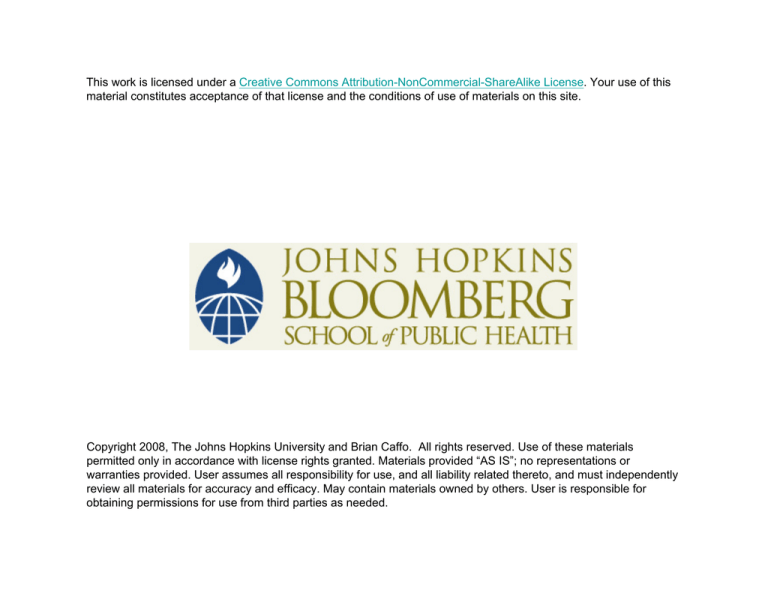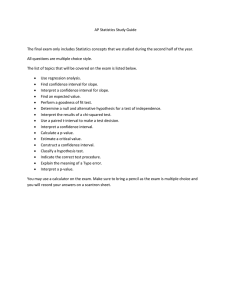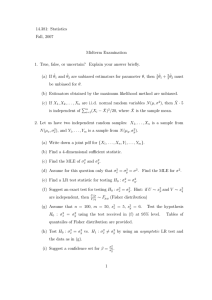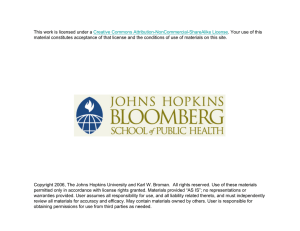
This work is licensed under a Creative Commons Attribution-NonCommercial-ShareAlike License. Your use of this
material constitutes acceptance of that license and the conditions of use of materials on this site.
Copyright 2008, The Johns Hopkins University and Brian Caffo. All rights reserved. Use of these materials
permitted only in accordance with license rights granted. Materials provided “AS IS”; no representations or
warranties provided. User assumes all responsibility for use, and all liability related thereto, and must independently
review all materials for accuracy and efficacy. May contain materials owned by others. User is responsible for
obtaining permissions for use from third parties as needed.
BST 140.652 Hypothesis Testing Review notes
1 Hypothesis testing for a single mean
1. The null, or status quo, hypothesis is labeled H0 , the alternative Ha or H1 or H2 ...
2. A type I error occurs when we falsely reject the null hypothesis. The probability of a
type I error is usually labeled α.
3. A type II error occurs when we falsely fail to reject the null hypothesis. A type II error
is usually labeled β.
4. A Power is the probability that we correctly reject the null hypothesis, 1 − β.
5. The Z test for H0 : µ = µ0 versus H1 : µ < µ0 or H2 : µ 6= µ0 or H3 : µ > µ0 constructs a
√ 0 and rejects the null hypothesis when
test statistic T S = X̄−µ
S/ n
H1 T S ≤ −Z1−α
H2 |T S| ≥ Z1−α/2
H3 T S ≥ Z1−α
respectively.
6. The Z test requires the assumptions of the CLT and for n to be large enough for it to
apply.
7. If n is small, then a Student’s T test is performed exactly in the same way, with the
normal quantiles replaced by the appropriate Student’s T quantiles and n − 1 df.
8. Tests define confidence intervals by considering the collection of values of µ0 for which
you fail to reject a two sided test. This yields exactly the T and Z confidence intervals
respectively.
9. Conversely, confidence intervals define tests by the rule where one rejects H0 if µ0 is not
in the confidence interval.
10. A P-value is the probability of getting evidence as extreme or more extreme than we
actually got under the null hypothesis. For H3 above, the P-value is calculated as P (Z ≥
T Sobs |µ = µ0 ) where T Sobs is the observed value of our test statistic. To get the P-value
for H2 , calculate a one sided P-value and double it.
11. The P-value is equal to the attained significance level. That is, the smallest α value
for which we would have rejected the null hypothesis. Therefore, rejecting the null
hypothesis if a P-value is less than α is the same as performing the rejection region test.
1
12. The power of a Z test for H3 is given by the formula (know how this is obtained)
µ0 − µ1
√ + Z1−α .
P (T S > Z1−α |µ = µ1 ) = P Z ≥
σ/ n
Notice that power required a value for µ1 , the value under the null hypothesis. Correspondingly for H1 we have
µ0 − µ1
√ − Z1−α .
P Z≤
σ/ n
For H2 , the power is approximately the appropriate one sided power using α/2.
13. Some facts about power.
a. Power goes up as α goes up.
b. Power of a one sided test is greater than the power of the associated two sided test.
c. Power goes up as µ1 gets further away from µ0 .
d. Power goes up as n goes up.
14. The prior formula can be used to calculate the sample size. For example, using the
0 −µ
√ 1 − Z1−α yields
power formula for H1 , setting Z1−β = µσ/
n
n=
(Z1−β + Z1−α )2 σ 2
,
(µ0 − µ1 )2
which gives the sample size to have power = 1 − β. This formula applies for H3 also.
For the two sided test, H2 , replace α by α/2.
15. Determinants of sample size.
a. n gets larger as α gets smaller.
b. n gets larger as the power you want gets larger.
c. n gets lager the closer µ1 is to µ0 .
2 Binomial confidence intervals and tests
1. Binomial distributions are used to model proportions. If X ∼ Binomial(n, p) then p̂ =
X/n is a sample proportion.
2. p̂ has the following properties.
a. It is a sample mean of Bernoulli random variables.
b. It has expected value p.
c. It has variance p(1 − p)/n. Note that the largest value that p(1 − p) can take is 1/4 at
p = 1/2.
2
d. Z = √
p̂−p
p(1−p)/n
follows a standard normal distribution for large n by the CLT. The
convergence to normality is fastest when p = .5.
3. The Wald test for H0 : p = p0 versus one of H1 : p < p0 , H2 : p = p0 , and H3 : p > p0
uses the test statistic
p̂ − p
TS = p
p̂(1 − p̂)/n
which is compared to standard normal quantiles.
4. The Wald confidence interval for a binomial proportion is
p
p̂ ± Z1−α/2 p̂(1 − p̂)/n.
The Wald interval is the interval obtained by inverting the Wald test (and vice versa).
5. The Score test for a binomial proportion is
TS = p
p̂ − p
p0 (1 − p0 )/n
.
The score test has better finite sample performance than the Wald test.
6. The Score interval is obtained by inverting the score test (and vice versa)
2
Z1−α/2
1
n
+ 2 n+Z 2
p̂ n+Z 2
1−α/2
1−α/2
s
±Z1−α/2
1
2
n+Z1−α/2
p̂(1 − p̂)
n
2
n+Z1−α/2
+
1
4
2
Z1−α/2
2
n+Z1−α/2
.
7. An approximate score interval for α = .05 can be obtained by taking p̃ =
calculating the Wald interval using p̃ instead of p̂.
X+2
n+4
and
8. An exact binomial test for H3 can be performed by calculating the exact P-value
n
X
n
pk0 (1 − p0 )n−k .
P (X ≥ xobs |p = p0 ) =
k
k=xobs
where xobs is the observed success count. For H1 the corresponding exact P-value is
xobs X
n
pk0 (1 − p0 )n−k .
P (X ≤ xobs |p = p0 ) =
k
k=0
These confidence intervals are exact, which means that the actual type one error rate is
no larger than α. (The actual type one error rate is generally smaller than α.) Therefore
these tests are conservative. For H2 , calculate the appropriate one sided P-value and
double it.
3
9. Occasionally, someone will try to convince you to obtain an exact Type I error rate using
supplemental randomization. Ignore them.
10. Inverting the exact test, choosing those value of p0 for which we fail to reject H0 , yields
an exact confidence interval. This interval has to be calculated numerically. The coverage of the exact binomial interval is no lower than 100(1 − α)%.
3 Group comparisons
1. For group comparisons, make sure to differentiate whether or not the observations are
paired (or matched) versus independent.
2. For paired comparisons for continuous data, one strategy is to calculate the differences
and use the methods for testing and performing hypotheses regarding a single mean.
The resulting tests and confidence intervals are called paired Student’s T tests and
intervals respectively.
3. For independent groups of iid variables, say Xi and Yi , with a constant variance σ 2 across
groups
X̄ − Ȳ − (µx − µy )
q
Z=
Sp n1x + n1y
limits to a standard normal random variable as both nx and ny get large. Here
Sp2 =
(nx − 1)Sx2 + (ny − 1)Sy2
nx + ny − 2
is the pooled estimate of the variance. Obviously, X̄, Sx , nx are the sample mean,
sample standard deviation and sample size for the Xi and Ȳ , Sy and ny are defined
analogously.
4. If the Xi and Yi happen to be normal, then Z follows the Student’s T distribution with
nx + ny − 2 degrees of freedom.
5. The test statistic T S =
Sp
X̄−Ȳ
q
1
+ n1
n
x
can be used to test the hypothesis that H0 : µx = µy
y
versus the alternatives H1 : µx < µy , H2 : µx 6= µy and H3 : µx > µy . The test statistic
should be compared to Student’s T quantiles with nx + ny − 2 df.
6.
Sx2 /σx2
Sy2 /σy2
follows what is called the F distribution with nx − 1 numerator degrees of freedom and ny − 1 denominator degrees of freedom.
7. To test the hypothesis H0 : σx2 = σy2 versus th hypotheses H1 : σx2 < σy2 , H2 : σx2 6= σy2 and
H3 : σx2 > σy2 compare the statistic T S = S12 /S22 to the F distribution. We reject H0 if:
H1 if T S < Fnx −1,ny −1,α ,
H2 if T S < Fnx −1,ny −1,α/2 or T S > Fnx −1,ny −1,1−α/2 ,
4
H3 if T S > Fnx −1,ny −1,1−α .
8. The F distribution satisfies the property that Fnx −1,ny −1,α = Fny −1,nx −1,1−α . So that, it
turns out, that our results are consistent whether we put Sx2 on the top or bottom.
9. Using the fact that
Sx2 /σx2
1 − α = P Fnx −1,ny −1,α/2 ≤ 2 2 ≤ Fnx −1,ny −1,1−α/2
Sy /σy
i
h
2
2
σ2
we can calculate a confidence interval for σy2 as Fnx −1,ny −1,α SSx2 , Fnx −1,ny −1,1−α/2 SSx2 . Of
y
y
h x
i
Sy2
Sy2
σx2
course, the confidence interval for σ2 is Fny −1,nx −1,α S 2 , Fny −1,nx −1,1−α/2 S 2 .
y
x
x
10. F tests are not robust to the normality assumption.
11. The statistic
X̄ − Ȳ − (µx − µy )
q
Sy2
Sx2
+
nx
ny
follows a standard normal distribution for large nx and ny . It follows an approximate
Students T distribution if the Xi and Yi are normally distributed. The degrees of freedom are given below.
12. For testing H0 : µx = µy in the event where there is evidence to suggest that σx 6= σy ,
Ȳ
the test statistic T S = rX̄−
follows an approximate Student’s T distribution under
2
S2
Sx
+ ny
nx
y
the null hypothesis when Xi and Yi are normally distributed. The degrees of freedom
are approximated with
(Sx2 /nx + Sy2 /ny )2
.
(Sx2 /nx )2 /(nx − 1) + (Sy2 /ny )2 /(ny − 1)
13. The power for a Z test of H0 : µx = µy versus H3 : µx > µy is given by
µx − µy
P Z ≥ Z1−α − q 2
σ2
σx
+ nyy
nx
while for H1 : µx < µy it is
µx − µy
P Z ≤ −Z1−α − q 2
.
σy2
σx
+
nx
ny
14. Sample size calculation assuming nx = ny = n
n=
(Z1−α + Z1−β )2 (σx2 + σy2 )
.
(µx − µy )2
5







